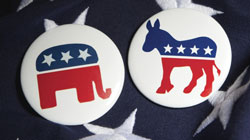The term “Going Green” sparked a revolution among advertising companies the moment the movement was seen as a money making concept. Environmentalists and those in support of monitoring the welfare of the planet became an advertiser’s dream come true.
As soon as a product that is allegedly made from recycled and eco-friendly materials hits the market, it flies off of the shelves. Even products that aren’t advertised as being eco-friendly can become trends with the right “saving the planet” logo.
Companies are charging high prices for average items that they claim are made from organic materials. An average t-shirt sold by hippychixshop.com costs $26, simply because it is made from organic cotton. It is “super soft, naturally clay dyed”, and also features the words “Go Green” across the front of the shirt. Last time I checked, the average person didn’t need to spend more than $5 on a basic, everyday t- shirt he or she may only end up wearing to the gym or to run errands, simply because it was made from special materials and advertised his or her love for the planet. Whether it is made from polyester or organic cotton, at the end of the day, a t- shirt is still only a t- shirt.
People have worn clothing made from regular cotton for as long as anyone can remember, but all of sudden, we are being told that organic cotton is the way to go. We all need to go out spend an extra $20 per clothing item because it’s a great way to live sustainably, not to mention that our “old fashioned” cotton is suddenly made using harmful chemicals.
Shoppers can walk into any Walmart or Bed, Bath, & Beyond and buy an effective, hand-held flashlight for $7.99, but a “solar hybrid” flashlight sold by gogreenitems.com sells for $19.99.
Not only are people being duped into buying products that they do not need, but they are also being cheated on a much larger scale. Contractors across the country promised homeowners that they would be saving money by going green, but in actuality, these homeowners have lost money and aren’t getting anything in return.
According to the Consumer Advocate Legal Update website, some homeowners cite spending more than $7,000 to have solar panels installed on their roofs, after being promised that they would be saving $1,000 per year on their electric bills, but they haven’t saved anything. In 2010, the Better Business Bureau received complaints from several hundred people who were taken advantage of by contractors who guaranteed that they would see the benefits of going green.
Don’t get me wrong. I am a firm believer in the concept that people should do more to better sustain the planet, but this idea isn’t what advertisers have in mind. Buying organic t-shirts, special computer paper, and coffee mugs that say “Hello, I’m Going Green” isn’t going to help with pollution and global warming. Advertisers and the companies that are producing and selling these products are only in the business to do just that: produce, market and sell their products.
In his article titled “Business begins to see profit in going green,” Brad Knickerbocker, a writer for csmonitor.com, says, “It’s not just environmental do-gooderism in a power tie. Increasingly, businesses are finding that going green can be profitable.”
The bottom line is that manufacturers and advertisers are only in business to profit, and the “Going Green” movement has had these companies seeing green: green dollar signs. Today’s business world isn’t supporting the eco-friendly lifestyle because it wants to offer people a better way to help the environment. The industry is only promoting this movement so long as it keeps the cash rolling in, and it is about time consumers realize that they are being deceived.




